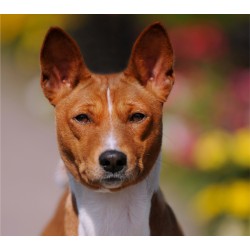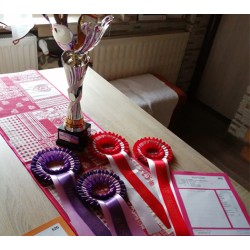— Your Type of Dog?
What is a Basenji?
Owners will testify to the Basenji’s phenomenal intelligence, his inventiveness, his curiosity, and his clownish sense of humor. An independent thinker, the Basenji is charming as well as trying. Reared with affection as well as discipline, a Basenji makes a delightful companion. These major personality traits are loved by Basenji enthusiasts but the breed is definitely not for everyone.
He is active and resourceful at play and cozy and comfortable in repose.
He will demand attention at times but is not a clinging dog. He will keep good track of what you are up to without constantly requiring your attention.

The silent hunter is not going to bark to frighten off an intruder. They do become alert and interested when friend or stranger approaches the home or if there are odd noises. People acting suspiciously will upset a Basenji. Many Basenjis will try to avoid a suspicious intruder. Some may happily greet an intruder while a few may try to protect their home. Do not count on a Basenji as a traditional guard dog.
The Basenji is immaculate, grooming his coat and paying particular attention to his feet, again, like a cat. He takes such good care of himself that he rarely needs a bath. This is certainly a good thing, as the Basenji does not enjoy getting wet. An occasional brisk rub with a rough towel and a going-over with a soft brush will delight him and will cause his coat to glisten. The Basenji is practically odorless. If there is any scent at all, it is reminiscent of clean, dry grass.
Coming from Africa originally, the Basenji enjoys warmth. During very cold weather he can be outside while he is active. He will hate the rain, avoiding it like the plague, but enjoy a good romp in fresh snow.
Personality and Physical Traits Chart
| Personality Traits | What This Means For You! |
| Active and curious personality |
|
| Proud, independent and stubborn nature |
|
|
|
| Basically a friendly dog but can be aloof with strangers |
|
| Agile |
|
| Non-barking BUT not mute |
|
| All-purpose hound |
|
| Pack mentality |
|
| A smallish medium sized dog |
|
| Clean, smooth coated dog |
|
| One Oddity |
|
Is a Basenji Right for You?
An interesting quote found at Basenji Companions on the internet: “They are not a typical domesticated dog, and it is unfair to expect them to act like what you might expect of a lethargic house dog.” Basenjis are not for everyone; it seems people love them and truly enjoy their qualities or hate the breed because of the same basic qualities. Will you be one of those who find them to be an amusing character, fun and an interesting challenge or will you think they are impossibly disobedient and basically destruction on four legs?
Consider Your Answers to These Ten Questions
-
If you have been accustomed to dogs with low energy levels, will you be happy with the active, curious temperament of the Basenji?
-
Do you have high energy levels to help your Basenji expand his energy through exercise?
-
Because of his agility and curiosity, a Basenji’s special needs require you to keep him safe and secure. Can you provide the environment inside and outside your home?
-
If your concept of a dog is a loyal, obedient companion, are you going to be happy with an independent and naughty Basenji?
-
Are you willing to work with your Basenji using the most modern training techniques right from the beginning?
-
Because they possess a hunting instinct, Basenjis tend to roam and should be kept in an enclosed area. Are you able to provide this type of environment for your Basenji?
-
Basenjis do not do well when left alone for long periods. Will you have the time to give your Basenji a great deal of attention and affection?
-
Basenjis make a poor guard dog. Is this acceptable to you?
-
The decision to bring a new Basenji into your home should be one that is agreed upon by all members of the family. Most Basenjis live long lives of 12-14 years and sometimes even more. Are you willing to make this commitment?
-
Do you have the kind of sense of humor that will tolerate the Basenjis “non-doggy” temperament?
If you have answered yes to the above questions then a Basenji may be the right dog for you!
Two typical diseases for Basenji breed
PRA - Progressive Retinal Atrophy
PRA stands for Progressive Retinal Atrophy, which is a group of genetic disorders that affect the retina in dogs and can lead to vision loss and blindness. A “clear” PRA status means that a dog has been tested and does not carry the genetic mutation that causes PRA. This means that the dog is not at risk of developing PRA and will not pass the mutation on to its offspring if it is used for breeding.
About PRA
Progressive Retinal Atrophy (PRA) is a group of genetic disorders that affect the retina in dogs. The retina is a layer of cells at the back of the eye that is responsible for detecting light and converting it into signals that the brain can interpret as vision. In dogs with PRA, the cells in the retina begin to degenerate, leading to vision loss and eventually blindness.
The onset of PRA can vary, but it usually begins in middle age and progresses slowly over time. In the early stages of PRA, dogs may experience night blindness, which means they have difficulty seeing in low light conditions. As the condition progresses, they may have difficulty seeing during the day as well. In the advanced stages of PRA, dogs may become completely blind.
Fanconi Syndrome Basenji Type (FS)
Fanconi Syndrome Basenji type is a genetic disorder caused by proximal renal tubular dysfunction. Fanconi syndrome was named after swiss doctor Guido Fanconci, who was first to describe the disorder in 1936. Canine Fanconi syndrome was first reported in 1976 in Basenji dog breed. FS can be divided into hereditary and idiopathic (the cause is not known). Idiopathic FS has been identified in the Norwegian Elkhound, Labrador Retriever, Shetland Sheepdog and Miniature Schnauzer. Forms of FS that are acquired as result of toxic effects of certain drugs or heavy metal poisoning are also common.
Characteristics and Symptoms
In Fanconi syndrome proximal renal tubular epithelial cells are insufficient, which leads to the urinary leakage, or insufficient apsorption of essential metabolites such as phosphate, uric acid, glucose, amino acids and low molecular weight proteins.
First symptoms of Fanconi syndrome in Basenjis are exhibited around 3 to 7 year of age. Clinical signs are excessive drinking (polydipsia), excessive urination (polyuria), glucose in the urine (glucosuria), because the kidneys are unable to conserve water. Other symptoms are also weight loss and poor hair coat. If the disorder is left untreated for longer time, due to the loss of nutrients and electrolites in the urine, muscle wasting, acidosis, and poor condition will develop. In case of rapid progress of disorder into kidney failure, signs as poor appetite, extreme loss of weight, lethargy, vomiting and pale gums due to anemia will appear. Due to glucose in the urine, affected dogs are prone to urinary tract infection.
When untreated at all, affected dog will eventually die from the disorder. If the disorder is treated on time, individual affected dogs can do well with their condition. Since affected dogs have urinary leakage, to determine wether the dog is affected, urine glucose test strips are used. Those test strips show presence or absence of glucose in the urine. Veterinarian examination include urine specific gravity, glucosuria with normogylcemia, phosphaturia and aminoaciduria.
Genetics
Fanconi Syndrome Basenji type (FS) is caused by a mutation in FAN1 gene (Fanconi anemia-associated nuclease 1), which is a part of the myotubularin gene family of tyrosine phosphatases. Gene name has been proposed because FAN1 protein interacts with Fanconi anemia (FA) pathway proteins. FA and FS in Basenjis are caused by mutation in same gene, but these two disorders are distant. This muation causes FAN1 inactivation, which results in hyper-sensitization of the proximal tubule cells to low concentrations of heavy-metals in FS affected Basenjis. Since affected dogs are differently exposed to environmental toxins, this exaplins the wide range of ange of onset for Fanconi syndrome in Basenjis.
The disorder is inherited as an autosomal recessive trait. Healthy parents of an affected dog are obligate heterozygotes, and therefore carry one mutant allele. Heterozygotes have no symptoms. At conception, each cub has a 25% chance of being affected, a 50% chance of being an asymptomatic carrier, and a 25% chance of being unaffected and not a carrier.
Medical results for both parents of our puppies:
Fanconi Syndrome: Genotype N/N (clear)
PRA Basenji: Genotype N/N (clear)



